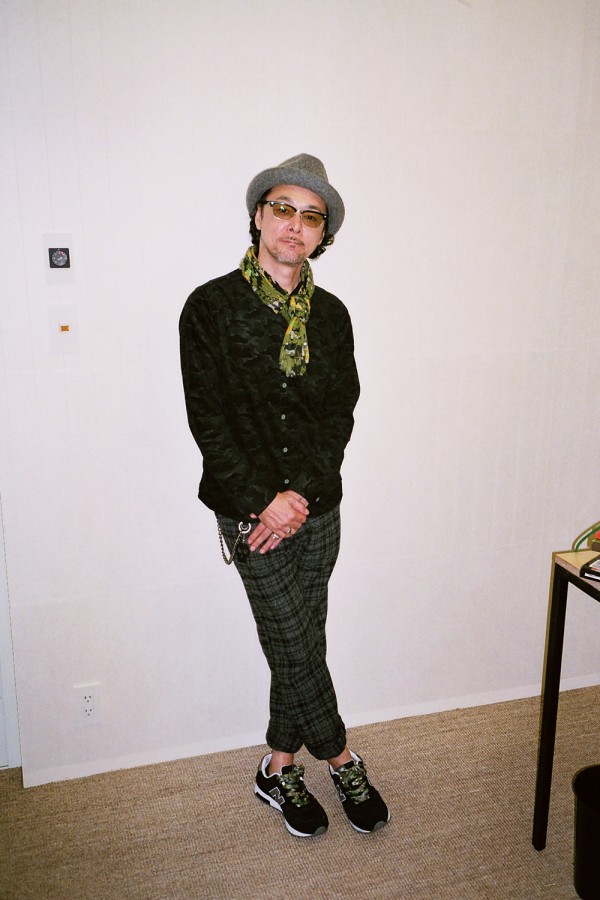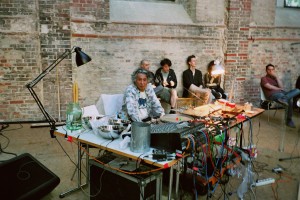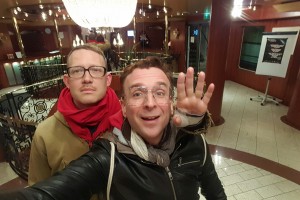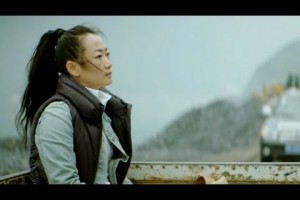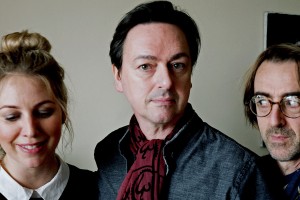The Gallery of Hōryū-ji
On a rainy night in October 2014, DJ Krush took over the so-called Garden Beyond at Tokyo’s National Museum to play a unique concert in front of the embodies of Japan’s eternal timelessness. In front of The Gallery of Hōryū-ji Treasures he interacted with five musicians trained in classical japanese instruments, which added some next level mystique to his old school hiphop-scratching.
Thomas Venker sat down with Hideaki Ishi the very next day for a deeper talk about the specific character of Japanese instruments.
Hideaki Ishi. Let´s start of with your performance at the National Museum. How was it for you? Even in your long and exciting career this must have been a special occasion?
We were able to perform what we originaly imagined. Unfortunately you can’t beat the forces of nature – the rain took away some of our plans, so we did not end with 200% performance quality but still 120%! We had to bring up a tent which had some negative effects on the sound – the rehearsal sounded much better. But besides that I was very happy.
It is always a special moment for a musician when his art makes it to the museum. Especially for a club musician like you I guess.
Well, it is a rare location for sure. In the past I’ve already performed at a big temple in Tokyo: I played together with monks – the head monk is really into music. In the main hall, where the monks regulary play, I renovated the floor and cut out a shape of an 8 and put a big speaker in. When you play down there, the sound is very special. In the main hall they have a Buddha statue, so the older people come in the temple and sit down in front of it to pray – and this time they had the deep sound coming from below as the soundtrack to their prayers. That said, it was not so unusual for me to perform at the National Museum, but still something special.
As a child you dropped out of school. Now you perform in front of the Gallery of Hōryū-ji. I wonder about your notes in history back in the days.
I was not so good at history, but I was very good at art. Some of my drawings and crafting at school won awards. One drawing of a monster was even shown on television as an example of good art.
When did you start to get interested in traditional Japanese instruments?
Kids in japan don´t grow up listening to traditional japanese music. If you turn on the radio, all you hear is modern, international, western music and Japanese pop music. I was not different in that sense from all other kids. My interest for traditional Japanese instruments came up after I became a DJ and started to travel internationaly, that was during the 1995 tour for my album „Meiso“. Once you exprience foreign countries you start to think also about your home environment. That made me aware how much our country is different from these other ones.
Looking at the long list of traditional Japanese instruments I found during my research, a list of around 100 of them, I wondered how you chose which ones you wanted to use.
It was all about drawing a scene. It is like a field which allows the flowers to grow on it. Or like filling a pool with water, so you could swim in it – but who will actually fit in for swimming, you will not know before you do it.
In that sense the Shakuhachi, a bamboo flute used for Zen meditation, played by a gentlemen next to my turntables, was a starting point. The sound of it is very emotional and the tone is quite special. It is very free floating. That touched me.
Regarding the drums, they were very hard to integrate in the recording.
Which other two instruments on the list do you like most and why?
There are a lot of good ones. You researched well! The koto is a very nice one too. It is like a long zither. The tone is very distinctive, a sound that every Japanese person is closely connected to. On special occasions, like on New Year’s Eve, the koto is played everywhere. When you hear it you feel very much at home. There are different ones existing, all of them are good ones.
Another favorite of mine is the taiko, a big drum with this very big sound. It makes the air vibrate. Not many instruments create that kind of vibration. You only hit it once, but that’s enough. You see it a lot when you go to street fairs and carnivals as part of their festival activities. We have this tradition of street dances, and the drum is always in the middle of the happening. Children come up and play it. So it is a big part of our history. It touches my heart.
How did you chose the musicians you worked with?The two monks, who play Gagaku style, an elegant music form which goes back to the 7th century and was played during the Heian aera at the Emperor’s palace, I performed with them ten years ago at the temple I mentioned before. They played hichiriki, a double reeded instrument, and sho, a 17-pipe mouth organ.
The player of the taiko, the big drum, it was the first time I performed with him, but I’ve made remixes of taiko tracks in the past, so we had a relationship.
The gentleman who played shakuhachi, the bamboo flute, he played on two tracks of my album „Jaku“ and toured with me in 2004 in Europe – which must have been hard for him as he is quite old.
How often and how long did you rehearse?
About three times.
Oh, i expected more! Do you have any plans to record the music of the performance?
Yes but not limited to Japanese traditional music, more multi-racial. I want to do an album using special instruments from different countries.
Is it scheduled?
Not yet. It is an idea I will follow. There are plans for a new album and I like that possibility.
It is quite some time since you released an album, especially as you have been very active before. Between „Krush“ in 1994 and „Jaku“ in 2004 you did eight records in one decade, and afterwards none.
I am so busy DJing everywhere. But everybody is asking, I guess I have to get seriously behind that.
From DJ to bandleader/conductor – was this a big leap for you? Or is it just being a director in a different way?
There was that element of being the band leader, most of all with the gagaku players as they have very strict rules within their form of music – they were stepping outside of their normal routine a bit, so I had to lead them. In terms of percussion the player brought in a lot of his own ideas. All of them are masters in their own rights as they study their instruments for such a long time. So I do not feel like I am in the position to make orders, but as they are humble persons, they checked with me all the time anyway.
What is your first musical memory about Japan.
The oldest memory I have is watching television shows, especially rangers storys and godzilla, the theme music of those shows.
Hideaki Ishi, thank you very much for your time.







